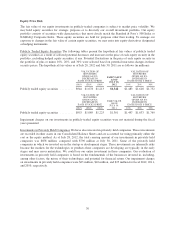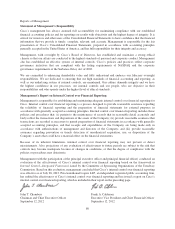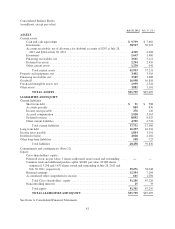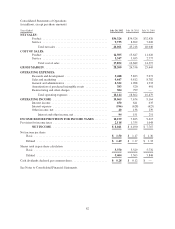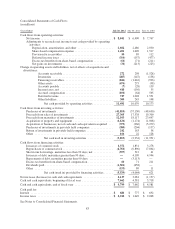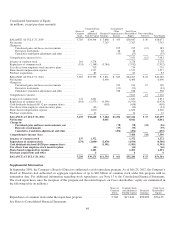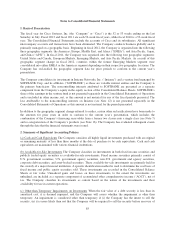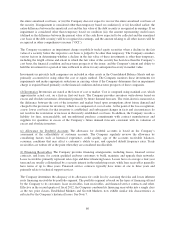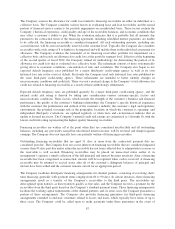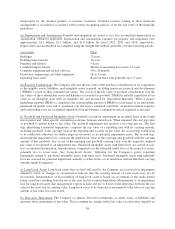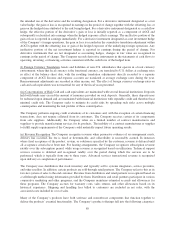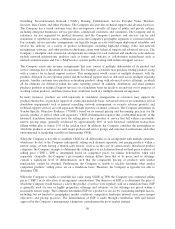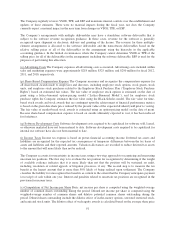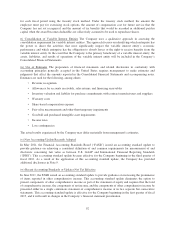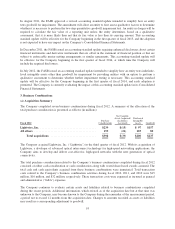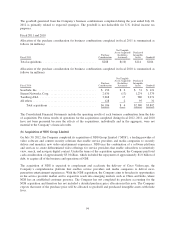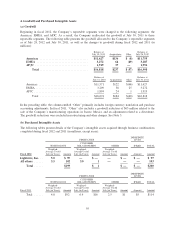Cisco 2012 Annual Report Download - page 93
Download and view the complete annual report
Please find page 93 of the 2012 Cisco annual report below. You can navigate through the pages in the report by either clicking on the pages listed below, or by using the keyword search tool below to find specific information within the annual report.
Notes to Consolidated Financial Statements
1. Basis of Presentation
The fiscal year for Cisco Systems, Inc. (the “Company” or “Cisco”) is the 52 or 53 weeks ending on the last
Saturday in July. Fiscal 2012 and fiscal 2011 are each 52-week fiscal years, while fiscal 2010 is a 53-week fiscal
year. The Consolidated Financial Statements include the accounts of Cisco and its subsidiaries. All significant
intercompany accounts and transactions have been eliminated. The Company conducts business globally and is
primarily managed on a geographic basis. Beginning in fiscal 2012, the Company is organized into the following
three geographic segments: the Americas; Europe, Middle East, and Africa (“EMEA”); and Asia Pacific, Japan,
and China (“APJC”). In fiscal 2011, the Company was organized into the following four geographic segments:
United States and Canada, European Markets, Emerging Markets, and Asia Pacific Markets. As a result of this
geographic segment change in fiscal 2012, countries within the former Emerging Markets segment were
consolidated into either EMEA or the Americas segment depending on their respective geographic locations. The
Company has reclassified the geographic segment data for prior periods to conform to the current year’s
presentation.
The Company consolidates its investment in Insieme Networks, Inc. (“Insieme”) and a venture fund managed by
SOFTBANK Corp. and its affiliates (“SOFTBANK”) as these are variable interest entities and the Company is
the primary beneficiary. The noncontrolling interests attributed to SOFTBANK are presented as a separate
component from the Company’s equity in the equity section of the Consolidated Balance Sheets. SOFTBANK’s
share of the earnings in the venture fund is not presented separately in the Consolidated Statements of Operations
and is included in other income, net, as this amount is not material for any of the fiscal periods presented. The
loss attributable to the noncontrolling interests on Insieme (see Note 12) is not presented separately in the
Consolidated Statements of Operations as this amount is not material for the periods presented.
In addition to the geographic segment change referred to earlier, certain other reclassifications have been made to
the amounts for prior years in order to conform to the current year’s presentation, which includes the
combination of the Company’s financing receivables from a former two classes into a single class (see Note 7)
and re-categorization of the Company’s products (see Note 16). The Company has evaluated subsequent events
through the date that the financial statements were issued.
2. Summary of Significant Accounting Policies
(a) Cash and Cash Equivalents The Company considers all highly liquid investments purchased with an original
or remaining maturity of less than three months at the date of purchase to be cash equivalents. Cash and cash
equivalents are maintained with various financial institutions.
(b) Available-for-Sale Investments The Company classifies its investments in both fixed income securities and
publicly traded equity securities as available-for-sale investments. Fixed income securities primarily consist of
U.S. government securities, U.S. government agency securities, non-U.S. government and agency securities,
corporate debt securities, and asset-backed securities. These available-for-sale investments are primarily held in
the custody of a major financial institution. A specific identification method is used to determine the cost basis of
fixed income and public equity securities sold. These investments are recorded in the Consolidated Balance
Sheets at fair value. Unrealized gains and losses on these investments, to the extent the investments are
unhedged, are included as a separate component of accumulated other comprehensive income (“AOCI”), net of
tax. The Company classifies its investments as current based on the nature of the investments and their
availability for use in current operations.
(c) Other-than-Temporary Impairments on Investments When the fair value of a debt security is less than its
amortized cost, it is deemed impaired, and the Company will assess whether the impairment is other than
temporary. An impairment is considered other than temporary if (i) the Company has the intent to sell the
security, (ii) it is more likely than not that the Company will be required to sell the security before recovery of
85



